The contemporary Belgian scene is a unique one which unites graphic design, the free-culture movement,11 See Anthony Masure, Alexandre Saint-Jevin, “Recherche et culture libre : approche critique de la science à un million de dollars,” Réel-Virtuel, 6, Les normes du numérique, (December 2018), http://b-o.fr/reel-virtuel and the concept of transmission. Graphic designer and teacher Alexia de Visscher provides a subjective view of the practices and networks in the region and their influence on pedagogical practice in art schools. To support her arguments, she makes use of documentation on workshops, labs, and courses that tell a tale of a practice on the margins, where everything seems possible.
The interest in issues surrounding reading online in art schools is relatively recent and closely linked to the democratization of the Web in the 2000s. Paper books having remained the most valid and “legitimate” means of publication, the teaching of graphic design has long been subservient to the printed publication. From the very first appearance of graphical user interfaces (in the 1980s), the pedagogy of design was orientated towards the “digitally assisted”—the passage to the screen was then considered an intermediate phase (or “inter-Media”) in the process towards the creation of a print work with a result in keeping with the original image (i.e. WYSIWYG, or “what you see is what you get”). At the time, most computer courses were dissociated from courses in artistic creation and graphic design students had no idea of the computational procedures associated with the interfaces with which they were working, nor of their relationship to the machine. This tenacious belief in the printed work as the ultimate aim also tended to widen the gap between these two worlds, both of which already were perceived as somewhat impenetrable.
The development of Web technologies and other platforms for its consultation (tablets, smartphones) engendered increasingly accessible and widely distributed forms of onscreen reading. As reading habits began changing, the necessity of providing content which was both available for consultation onscreen (in general, more rapid methods such as distant reading) and on paper (close reading) became increasingly evident. In the field of editorial design, in contact with free-culture, experiments and interactions appear, upending the paradigm of the screen as a space for simulation.22 Sherry Turkle, Life on the Screen: Identity in the Age of the Internet, (New York: Simon and Schuster, 1995). Thenceforth, it was with a screen (design)—and no longer onscreen (representation)—that graphic and semantic inscriptions were made, creating models for new editorial production processes whose main features are simultaneity and synchronicity. “Hybrid” publications (multimedia) began to appear, shattering the unending prophecies about the death of the book:33 “This Will Destroy That, the Book will Destroy the Edifice:” Victor Hugo, Notre-Dame de Paris, 1482, Book V, (New York: P.F. Collier & Son, 1917). Published online by Bartleby.com, (2000), http://b-o.fr/hugo
Publishing or hybrid publication is a term that encompasses forms of publication that coexist in several formats—printed, oral, [digital], etc.—where the content can exist simultaneously in several different and complementary forms, bringing into play the question of what exactly is a “publication.”44 Loraine Furter, “Trouble dans le genre—Pédagogie alternative de l’édition hybride,” Design-Research.be, April 2018, http://b-o.fr/furter
Belgian Origins
The little country of Belgium constitutes a sort of cultural interzone which brings together designers concerned with to creative and political freedom, who feel that the free-culture movement provides a means of questioning and exploring their discipline. Often organized into collectives, they study digital tools which create forms in order to adapt, transform and combine them. Rejecting the use of proprietary software in favor of free software, their actions engendered collaborative and horizontal methods of work that reformulated the role of the graphic designer and resulted in pedagogical experiments in art schools.
Pioneers in the field, it was probably not by chance that the “caravan” of Open Source Publishing (OSP) found a home in Belgium. OSP was founded in 2006 by Femke Snelting and Harrisson; it united graphic designers (notably graduates of the Master’s Program in Media Design from the Piet Zwart Academy) around the issues of open source and free license works. They organized print parties, 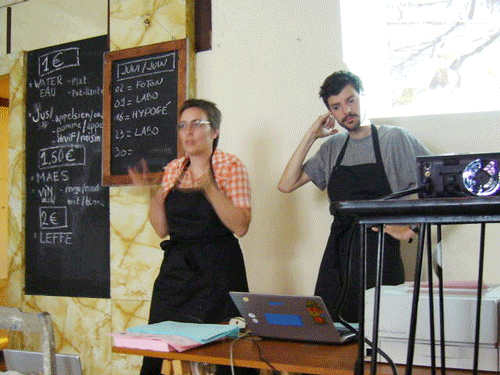 events that included workshops and “recipes” that were performed as they tested their experiments and research regarding the graphics industry on the public. They integrated, from the very beginning, notions of mediation, sharing, and pedagogy. Expanding this approach, they shared their process through a series of workshops they held at art schools (both in Belgium and abroad), proposing experiments linked to their ongoing projects. These collective sessions focus on the creative process, enabling graphic designers to resituate themselves at the heart of the research process, making them more than just users (or “at the service of”) softwares, but actors able to interact with and modify them, thus breaking free from the traditional division (“program or be programmed”).55 Douglas Rushkoff, Program or be Programmed: Ten Commands for a Digital Age, (New York: OR Books, 2011).
events that included workshops and “recipes” that were performed as they tested their experiments and research regarding the graphics industry on the public. They integrated, from the very beginning, notions of mediation, sharing, and pedagogy. Expanding this approach, they shared their process through a series of workshops they held at art schools (both in Belgium and abroad), proposing experiments linked to their ongoing projects. These collective sessions focus on the creative process, enabling graphic designers to resituate themselves at the heart of the research process, making them more than just users (or “at the service of”) softwares, but actors able to interact with and modify them, thus breaking free from the traditional division (“program or be programmed”).55 Douglas Rushkoff, Program or be Programmed: Ten Commands for a Digital Age, (New York: OR Books, 2011).
In addition to these workshops, Open Source Publishing organized the first Relearn summer school in 201366 http://relearn.be, as a ramification of their manifesto. Beyond the implications of the culture of free software in graphic design, Relearn challenged the paradigms of a traditional education by founding itself on a model of knowledge sharing, a portion of which took place outside institutions (forums, distribution lists, hackathons, wikis, etc.) introducing mobility into the roles at the heart of projects (teacher, student, developer, user, etc.).
Onscreen Publishing
The schools were still little inclined to these practices, each reviewed their relationship to digital in their own way. Sometimes as guest lecturers or as part of a teaching team, graphic designers who had emerged from the free-culture movement questioned hybridity and the apparently stable status quo regarding the tools then commonly used. Little by little, the public aspect of their teaching (documentation, events, publications, etc.) “contaminated” other schools and an alternative pedagogy began to emerge. Although it was identifiable, it tended to refuse institutionalization, or “being academic.” This was, in part, an aspiration of the Open Source Publishing collective which had been declared at the dawn of the Relearn movement which was now being realized: “We want to be contagious.”77 Eric Schrijver, Relearn, Introduction Script, 2013, http://b-o.fr/schrijver
This influence was, for example, made manifest in the course Actualités de l’Edition (“The Current State of Publishing,” part of the MULTI Masters program at the Royal Academy of the Arts, Brussels) directed by graphic designer Loraine Furter. This program invites students to compose a text, generally by using a word processing program, which the teacher then returns to them in the form of a webpage. The students are then asked to correct, complete or modify the text and its layout, eventually programming actions, such as adding hypertext links, or adapting the data flow based on the type of platform. The first version of the text produced resembles the traditional paradigms of onscreen writing and attempts to preserve the graphic properties of its inscription—what researcher Stéphane Crozat terms as writing “that wants to be printed.”88 Stéphane Crozat, “De l’écriture qui veut imprimer à l’écriture qui veut programmer,” Revue de l’ENSSIB, 4, (2016), http://b-o.fr/crozat The second (text converted to an HTML format and interpreted by a web browser) already underlies the semiotic and programming aspects99 See Isabelle Stengers, “Les alternatives infernales,” Au Temps des Catastrophes: Résister à la barbarie qui vient [2008], (Paris: La Découverte, 2013). of a writing “that wants to be programmed,” and even more so, one that “wants to publish.”1010 Stéphane Crozat, op. cit.
The practice of collaborative, synchronous or asynchronous writing is also a part of this continuity between writing and publication. This is the core of the Cultures Numériques (“digital cultures”) course 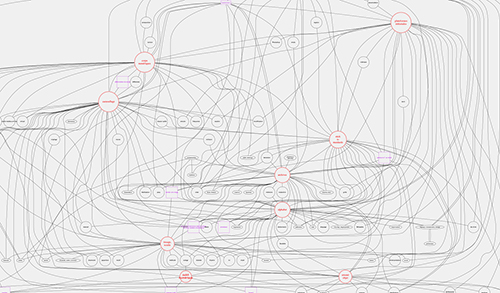 at the École de Recherche Graphique (ERG, Brussels) currently being co-taught by Stéphane Noël, Alexia de Visscher, Lionel Maes, Ludi Loiseau, Stéphanie Vilayphiou and Wendy Van Wynsberghe. Within this framework, a workshop focusing upon digital publication platforms was conducted by Camille Pageard in 2014. Its aim was to lay out a panorama of the different editorial processes which take place onscreen. The surveyed cases were essentially collective inscriptions, from Etherpad (2008) by way of MediaWiki (2002) or editing platforms made up of a series of customized tools like Ethertoff (2012), developed by the <o> future <o> collective, HTML2Print (2014) created for the journal Medor,1111 Belgian trimestrial cooperative review of investigations and stories, http://b-o.fr/medor or A.nnotate (2008),1212 http://a.nnotate.com an interface designed for the collaborative annotation of the work Revolution: A Reader (2012), edited by Matthew Stadler, the founder of Publication Studio.
at the École de Recherche Graphique (ERG, Brussels) currently being co-taught by Stéphane Noël, Alexia de Visscher, Lionel Maes, Ludi Loiseau, Stéphanie Vilayphiou and Wendy Van Wynsberghe. Within this framework, a workshop focusing upon digital publication platforms was conducted by Camille Pageard in 2014. Its aim was to lay out a panorama of the different editorial processes which take place onscreen. The surveyed cases were essentially collective inscriptions, from Etherpad (2008) by way of MediaWiki (2002) or editing platforms made up of a series of customized tools like Ethertoff (2012), developed by the <o> future <o> collective, HTML2Print (2014) created for the journal Medor,1111 Belgian trimestrial cooperative review of investigations and stories, http://b-o.fr/medor or A.nnotate (2008),1212 http://a.nnotate.com an interface designed for the collaborative annotation of the work Revolution: A Reader (2012), edited by Matthew Stadler, the founder of Publication Studio.
These examples remind us that writing is part of onscreen reading; whether it be in a hybrid form, or in a state where it is transitioning to a print format, it remains intimately linked to its medium of inscription. Indeed, “computer programs write in our place, or, at the very least, they condition our writing.”1313 Emmanuel Guez, Frédérique Vargoz, “La mort de l’auteur selon Friedrich Kittler,” Appareil, 19, (2017), http://b-o.fr/guez-vargoz Collaborative platforms, collective documentation, etc. ;the mobility of writing is progressively integrated in workshops as methods and places of introspection of the medium in which they are written:
Nowadays, with computers, [the author] cannot do without an understanding ;and [desire to] play with—the condition of all writing—both code and numbers. The author of post-1900 systems is no longer a scribe (creating manuscripts as per the 1800 system), nor an author who has become a secretary of the machines, but rather must put their finger to the pulse of the platform they are using, the explorer of the inscription system in which they are evolving. In the 21st century, they have become a sort of medium of the medium, seeking to reach the heart, indeed the double or quadruple heart of the processor.1414 Ibid.
This mobility brought about new pedagogical forms. From the world of remote control operations (WYSIWYG), to graphic descriptions connected to their semantics (WYSIWYM: “What you see is what you mean”), to self-conscious writing. Exploring formats and standards is a fruitful lead when questioning its resonance on the forms and uses of reading. Research centered around ePub, undertaken with students during a graphic arts course at ERG—which continued with a workshop conducted by graphic designers Eric Schrijver and Gijs de Heij, along with typographer Ludi Loiseau at the Haute École d’Art et de Design in Geneva (HEAD – Geneva)— proposes a study of the curious object that is the e-book. The students had no problem taking easily to this format with its “Web 1.0” look and examined the ways in which digital books could distinguish themselves from other digital content. How might one design interfaces and offer interactions between reading and writing? How might one subvert the paradigm of the printed book, and manipulate one’s way around the esthetics and display delays of e-readers? This workshop offered an opportunity to work on a book which was conscious of its own existence, capable of self-analysis both semantically and statistically, of writing itself (computationally), thus turning a publishable form with a will to program to good account, thanks to scripts written in the Python programming language.
Re-Reading, Re-Publishing
Beginning with the postulate according to which computer programs have practically replaced authors due to the degree to which they condition our writing,1515 Ibid. one might say that republishing digital textual material would be tantamount to “rewriting,” or otherwise put, inscribing new writings. Driven by these questions, the Mondothèque team1616 http://www.mondotheque.be ;a transdisciplinary initiative which brought together a group of projects associated with the figure of bibliographer Paul Otlet and his work ;hosted a “re-booksprint/hackathon” at the École Supérieure des Arts in Mons entitled Le Livre sur le Livre (“The Book on the Book”). They proposed to rethink the publication of the Traité de Documentation (“Treatise on Documentation”) which had just entered the public domain.1717 Paul Otlet, Traité de documentation: le livre sur le livre, (Bruxelles: Mundaneum, 1934). 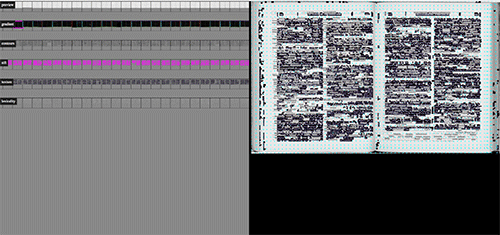 This work, published in 1934, combined a number of texts regarding the documentation and the state of the book, which were frequently predictive, including descriptions of the situation regarding censure, the history of the alphabet or “inventions to come,” alternating with precise explanations on the ways to reference books or indexes. Several experimental digital publications of the book were created based on original digitized Wikisource content. They in turn explored the form, materiality or content of the work from a programmatic perspective: algorithmic and poetic rewritings, ePub and dynamic indexing, the visualization of text onscreen or how the computer perceives the image of text.
This work, published in 1934, combined a number of texts regarding the documentation and the state of the book, which were frequently predictive, including descriptions of the situation regarding censure, the history of the alphabet or “inventions to come,” alternating with precise explanations on the ways to reference books or indexes. Several experimental digital publications of the book were created based on original digitized Wikisource content. They in turn explored the form, materiality or content of the work from a programmatic perspective: algorithmic and poetic rewritings, ePub and dynamic indexing, the visualization of text onscreen or how the computer perceives the image of text.
Along the same line of thought, the students in the course on typography at ERG worked using the digitization of five Belgian magazines provided in JPG, PDF and XML (Alto) formats by the DIGIT service of the Royal Library of Belgium (KBR). After a discussion with the library team that works on the digitization and implementation of a script for converting Alto files (derived from an OCR algorithm) into plain text, the students marked up the texts in the magazine Le Bruxellois to provide a description of its formatting on a webpage. 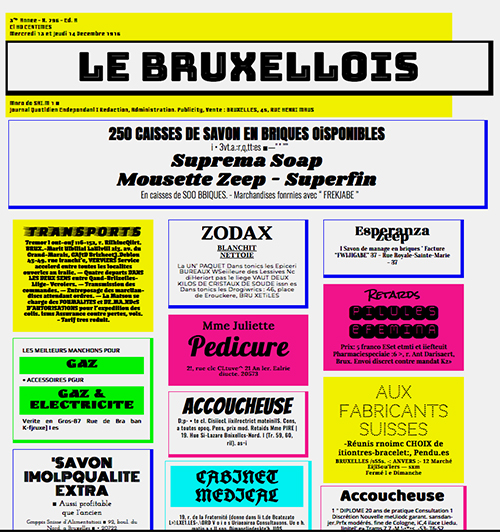 With some rudiments of syntax, these first-year students rapidly familiarized themselves with the basics of the HTML and CSS languages, and were introduced to the process of doing layout onscreen through semantic and descriptive organization of content. Putting technical apprenticeship at the heart of the pedagogy of a workshop project tends to break down the sterile opposition between programming and graphic design that the habits of the “digitally assisted” might have created along the way. The languages of graphic description are thus collectively learned, in situations where critical research and methodologies are formative, and where process is at the heart of practice. Between “visible text” (displayed in the image of the print publication), and “readable text” (which is described and interpreted), there is but one more step to be taken.
With some rudiments of syntax, these first-year students rapidly familiarized themselves with the basics of the HTML and CSS languages, and were introduced to the process of doing layout onscreen through semantic and descriptive organization of content. Putting technical apprenticeship at the heart of the pedagogy of a workshop project tends to break down the sterile opposition between programming and graphic design that the habits of the “digitally assisted” might have created along the way. The languages of graphic description are thus collectively learned, in situations where critical research and methodologies are formative, and where process is at the heart of practice. Between “visible text” (displayed in the image of the print publication), and “readable text” (which is described and interpreted), there is but one more step to be taken.
What Hybridization Does to Our Practices
By interacting with plain text, hybrid publications enable designers to free themselves from WYSIWYG interfaces through the use of explicit, formal syntaxes which reveal the semantic structure of the content. The use of digital tools, such as Web2print, HTML2print or Pad2print, in experimental publication workshops are increasing apace. Working from the same centralized content in order to produce multiple editing formats, adapted to each medium, helps resolve some of the reproaches made regarding nomadic and versatile digital content versus so-called “stable” versions of printed content.
Loraine Furter, who has followed the evolution of these practices closely, is working on an analysis of these new editorial formats and their modes of distribution.1818 Loraine Furter, op. cit. She tested the intuition born of her research in a series of workshops led at ERACOM in Lausanne. Year after year, the themes of these workshops attest to the progressive acquisition of the technologies of the Web by designers. From the ePub, produced in 2013 from printed matter, to multi-platform typographical specimens in 2016, by way of hybrid publications (ePub/website) in 2014, Furter has recently focused on the production of a digital layout tool which generates both screen and paper documents, enabling students to explore in detail the relationship between technology and publishing—from page design to the pedagogy of flow.
The Luuse collective was established in 2017 in Brussels. Its members, Antoine Gelgon, Léonard Mabille, Romain Marula, Étienne Ozeray, Marianne Plano and Baptiste Tosi, develop alternative techniques of editorial design and are part of a succession of designers who advocate for a “well thought-out, curious and conscious” approach to the relationship between design and production tools. They assert their affiliation with OSP and are direct inheritors of the previous efforts made by the stream of those who came before to obtain recognition for these marginal practices. Most of them are teachers in Belgian art schools and transmission enables them to create perennial tools which spread by capillarity between pedagogy and commission. In 2016, they conceived the first draft of Pad2print, a web tool for creating layout for printed items. Content (HTML) and formal instructions (CSS) are simultaneously published on two collaborative text editors in real time (pads). A web interface then combines the data from the two pads in a simulated onscreen format which can be exported to a PDF format. The whole makes up a flexible and protean printing tool that can be modified to accommodate each individual project.
They first tested Pad2print in a workshop at the École du 75 (Brussels). This workshop format was found to be particularly adapted to collaborative work and immediately raised specific problems. Collaborating synchronously on the same document enables students to question the notions of workspace (with whom), auctoriality (who), or the sharing of tasks (how): can I modify this paragraph or this CSS class which is written by someone else? How can one document and archive in a collaborative manner? How can one work on a text structure using synchronized writing practices?
Fluid Mechanics
From the adoption of CSS instruction at @font-face in 2010 to the contemporary developments of parametric and variable fonts whose “innovations were combined to impart a new fluidity to the drawing of type,”1919 Arthur Perret, “Sémiotique des fluides,” Infologie, http://b-o.fr/perret Web standards call for a greater visibility of typographical systems.
I begin with the following premise: typography is the only thing that remains of paper [printing] in the digital book. It is precisely this that makes it an interesting subject for study: it is a transition point between page and screen. What meaning can one produce with a system of changing signs?2020 Ibid.
In conjunction with this variability of type, the workshops of Ludi Loiseau at ERG and Pierre Huyghebaert at La Cambre (Brussels) offer programs where typography is no longer treated as a fixed and stable form, but rather one whose mutability of forms and tools becomes a basis for work in and of itself. Other examples include the experimentation in the Metamodel workshop, or how to question the digital ductus of the letter; the Gender Fluid workshop2121 http://genderfluid.space which examines the creation of “inclusive” characters, notably by exploring the work of new glyphs (letters, ligatures, median points, elements of links or symbiosis) or the recent module À Pleins Renversés2222 http://b-o.fr/a-pleins-renverses 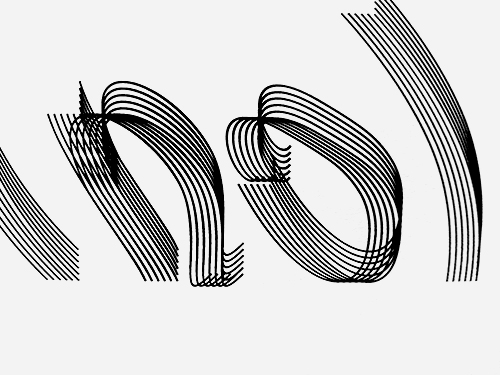 which examines the specificity of the drawing of typefaces at ERG, exploring six avenues of research: Ductus Folk, Tracé Paramétrique (“parametric plots”), Échelle de signe (“scales of character”), Formalsign, Ergbats and Animatype. The close links between lettering and tools is even a factor in the admission process to a school where some ERG candidates were offered the use of a plotter to draw parametric typefaces.
which examines the specificity of the drawing of typefaces at ERG, exploring six avenues of research: Ductus Folk, Tracé Paramétrique (“parametric plots”), Échelle de signe (“scales of character”), Formalsign, Ergbats and Animatype. The close links between lettering and tools is even a factor in the admission process to a school where some ERG candidates were offered the use of a plotter to draw parametric typefaces.
A Pedagogy of Possibilities
Belgian graphic design owes a great deal to the legacy of the work of Fernand Baudin, a master typographer of the 20th century, who was a professor at the NHIBS (Nationaal Hoger Instituut voor Bouwkunst en Stedebouw, Antwerp) where he taught the art of typography on a blackboard. In an entirely handwritten compendium, published in 1984,2323 Fernand Baudin, La typographie au tableau noir, (Paris: Retz, 1984). 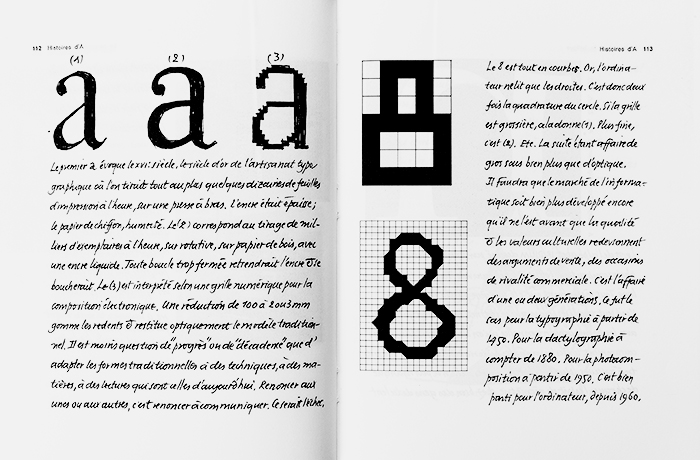 Baudin related the diversification of occupations and techniques involved in the design of the written, thus becoming the conveyor of a militant savoir-faire and history aimed at the teaching of a typography accessible to all. There might be a hint of impishness in his description of the demands and implications of the designer faced with his tools:
Baudin related the diversification of occupations and techniques involved in the design of the written, thus becoming the conveyor of a militant savoir-faire and history aimed at the teaching of a typography accessible to all. There might be a hint of impishness in his description of the demands and implications of the designer faced with his tools:
The significant point today is the [digitization] of the image and the text, in black and in color. This implies a radical change in the tasks [associated with] publishing, and, as a direct consequence, in the teaching of [all sorts of] writing. One must take into account the most recent discovery. Namely that, in daily reality, in both the short and middle term, computers do nothing on their own, and they do not do anything decent if one does not provide them with instructions that are infinitely more precise and detailed than all those one might have had to give to the biggest dunces of all the dunces.2424 Ibid.
Aware that, from that point forward, it would be a matter of providing instructions, Baudin assigns us the task of acquiring computer languages to prevent them from gaining ascendancy over our practices. Since then, computerized graphics and desktop publishing (DTP) techniques have continued to create a lag between writing media and the point of reception. These “assistants of creation” have endeavored to sell us a sort of illusion to which we have been in thrall, ignoring these differences. At a time when business is acquiring technologies at a disturbing speed, the experimental, independent and collaborative nature of the processes that are a product of free-culture are creating pockets of resistance in a digital world dominated by productivity models. Faced with this situation, how is it still possible to cultivate speculative thinking in art schools? Perhaps, thanks to what one might term the “pedagogies of doubt,” which designate a sort of “urgency of possibilities,” which Belgian philosopher Isabelle Stengers urges us to cultivate:
What we must activate today is thought that is committed to possibilities set within the context of a struggle against the adherence to the probable. Thought that is against any interpretation that would subscribe to the irresistible aspects of the rampant capitalistic upsurge that would have us believe that it is our destiny, even a privileged road towards progress and emancipation, while it really is leading us to the desertification of our worlds and our inability to conceive that all that we hold dear might have a future.2525 Didier Debaise and Isabelle Stengers, “L’insistance des possibles: Pour un pragmatisme spéculatif,” Multitudes, 65, (2016), 82–89.